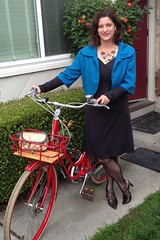My friend Deb called me last week: “I want a city bike for my birthday. Which ones should I look at? Where did you get yours?” First, I gave her the names of three of my favorite local shops that specialize in city bikes: A Street Bike Named Desire in Palo Alto, and Public Bikes and My Dutch Bike in San Francisco.
Then I started rattling off everything I’d learned in the past two years of transportation cycling, and what Dick and I learned from our recent city bike purchases. The more we chatted, the more I realized how many features we looked for when we bought our city bikes and how different it was than buying a road or mountain bike.

Don’t Be a Weight Weenie. When buying a road bike, the first thing most buyers do is pick it up. Road bikes are designed for speed and distance, and lighter weight can mean winning a race or finishing a century ride before they close the course. City bikes are designed to carry things so they need a heavier frame. And they’re designed for shorter distances, where slower speeds don’t make a big difference. Of course, if you have to carry it up stairs to an apartment or you live on a steep hill, you may want to check the weight. Just don’t obsess.
Frame the Question. You’ll need to decide whether you want a traditional diamond frame or a step through frame, aka a men’s bike or a women’s bike. Not that the decision lies with gender. Men sometimes choose a step-through so they don’t have to lift their leg high over the top tube. Women, especially ones who don’t wear skirts, sometimes choose the diamond frame. Side note: mixte frames are said to be named for “mixed gender.”

Upright, Not Uptight. Pedaling while upright feels odd at first if you’re used to a more aggressive position. You’ll still want to adjust the seat height and perhaps lower the bars a bit, but there’s little need for precise fitting. You won’t be bent over on the bike for hours and you won’t be locked into a single position on your pedals. So you won’t need to switch your stem or pull out a plumb bob to align your saddle to your pedals.
Size Matters, But Not So Much. Because they don’t require such precise fitting, city bikes come in fewer sizes. You’ll know the size is right if you don’t feel crowded between the seat and handlebars or too stretched out. If the bike is too small you may feel perched too high once your saddle is adjusted to the right height. And if you’re sitting on the top tube, your frame is too big. Nothing new there.

Gear Up. Most city bikes have 3-8 gears with a reasonably wide range. If you live in a city with steep hills, buy accordingly. But gear ratio range matters more than the number of gears, and it can be hard to know the range without a test ride. City bikes often have internal gear hubs, which protect the gears from street grime and protect your clothing from gear grime. Internal gear hubs are more expensive than derailleur-based gearing.
Try Before You Buy. As with any bike purchase, a test ride will tell you a lot. Is it easy to get on and off? Is it the right size? Does it feel balanced and track straight? Does it brake well? Does it shift well? Does it seem well-built? Do you feel “one with the bike?” Did riding it make you smile?

A Lasting Relationship. Consider the bike shop and its staff. They should be knowledgeable, friendly and helpful, and take time to answer your questions. If they primarily sell other types of bikes, make sure they value city bikes and understand their specific needs. If they tell you that you don’t need a kickstand or fenders, go elsewhere. Finally, if you don’t like the staff enough to want to go back to the shop, don’t buy the bike there.
What was most important to you when you bought your last bike? If money were no object, would you have bought something different?
This slideshow requires JavaScript.
P.S. Here are some great city bike shops Dick and I have visited on our travels:
Like this:
Like Loading...































